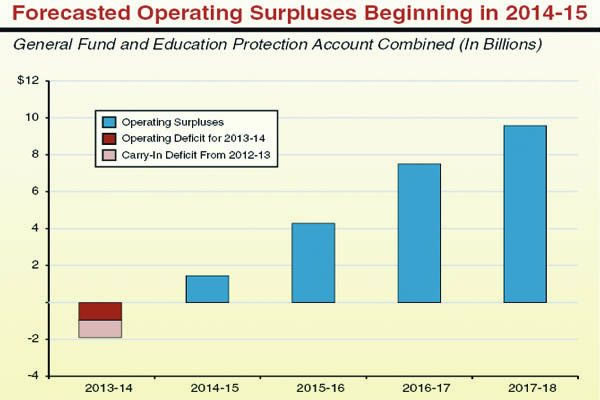LAO Forecasts a Surplus in California Come 2014


In a report released last week, California’s Legislative Analyst’s Office found that the state is facing budget gap of $1.9 billion for the fiscal year 2013-2014, but will likely see a budget surplus in California after 2014.
“We also expect that the state faces a $936 million operating deficit under current policies in 2013–14. These estimates mean that the new Legislature and the Governor will need to address a $1.9 billion budget problem in order to pass a balanced budget by June 2013 for the next fiscal year.”
Though the $1.9 billion figure is certainly troubling, this is far smaller than previous gaps in the budget. A similar LAO report from 2010 stated:
"Our forecast of California’s General Fund revenues and expenditures shows that the state must address a budget problem of $25.4 billion between now and the time the Legislature enacts a 2011–12 state budget plan. The budget problem consists of a $6 billion projected deficit for 2010–11 and a $19 billion gap between projected revenues and spending in 2011–12."
The apparent decrease, compared to last year’s projections, is predicated on several factors: the passing of Propositions 30 and 39 on November 6th, persisting economic growth, and continuing spending cuts that have been in place since last year. These assumptions are critical to realizing the comparatively small budget gap come 2013. The report also calls on legislators to address the $1.9 billion gap by June of 2013 and encourages a swift resolution to uncertainties surrounding the ‘fiscal cliff.’ If similar circumstances aren’t met, California’s projected surpluses in 2014 could be completely wiped out. The report states:
“If, however, a steady economic recovery continues and the Legislature and the Governor keep a tight rein on state spending in the next couple of years, there is a strong likelihood that the state will have budgetary surpluses in subsequent years.”
Should a budget surplus develop in 2014, the LAO offers several suggestions for uses of the funds, the first of which would make investments into California’s ‘rainy day fund,’ or Budget Stabilization Account, in 2015. Investments in the BSA could prove extremely beneficial should another economic downturn occur. Another recommendation is to address unfunded pension liabilities for California teachers. Current estimates show over $150 billion in pension obligations for California.
California could also use the surplus funds to restore services and funding that had previously been cut. These programs include “health and social services programs, schools, universities and community colleges, the courts, and state administration.”
The materialization of a budget surplus in 2014 heavily relies on multiple economic factors that are far from assured, yet it is becoming increasingly apparent that the apocalyptic budget forecasts of previous years are no longer at hand.


